 Every one has a story -- the painted ones are from Cosmo Place Studio, just down the road from work - have had those since the late 80s - they remind me of Ruth and of Vicky. The blue one from Halifax, the brown one from Plymouth - bringing to mind Rita and Erika. People who couldn't be further apart, geographically.
Every one has a story -- the painted ones are from Cosmo Place Studio, just down the road from work - have had those since the late 80s - they remind me of Ruth and of Vicky. The blue one from Halifax, the brown one from Plymouth - bringing to mind Rita and Erika. People who couldn't be further apart, geographically.
31 January 2006
Happy cups
 Every one has a story -- the painted ones are from Cosmo Place Studio, just down the road from work - have had those since the late 80s - they remind me of Ruth and of Vicky. The blue one from Halifax, the brown one from Plymouth - bringing to mind Rita and Erika. People who couldn't be further apart, geographically.
Every one has a story -- the painted ones are from Cosmo Place Studio, just down the road from work - have had those since the late 80s - they remind me of Ruth and of Vicky. The blue one from Halifax, the brown one from Plymouth - bringing to mind Rita and Erika. People who couldn't be further apart, geographically.
Chinese new year
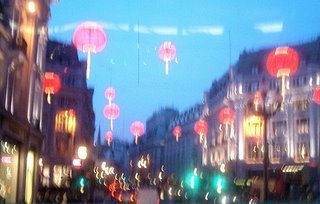
On Sunday we went to the V&A and encountered ... just about any Chinese cultural activity you can think of. The joint was jumping! Stilt walkers...
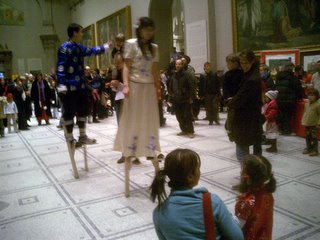
Calligraphy demonstrations (long queue of people waiting to get their name written in Chinese)...
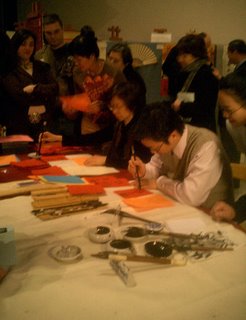 Traditional music...
Traditional music...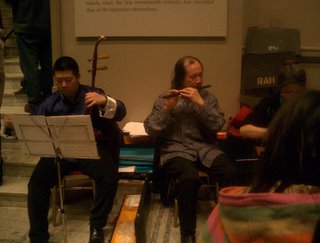 Drumming and dancing...
Drumming and dancing...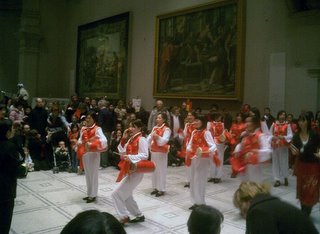 Vegetable carving...
Vegetable carving... Chinese chess, mah jong, people in costume wandering around... and everyone was taking photographs, of course.
Chinese chess, mah jong, people in costume wandering around... and everyone was taking photographs, of course.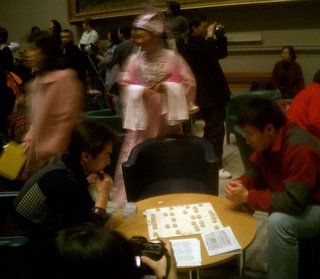 A calligraphy exhibition...
A calligraphy exhibition...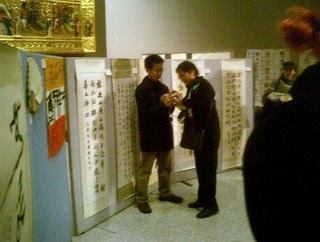 And behind the scenes, a reminder of the preparation and organisation needed for such an event.
And behind the scenes, a reminder of the preparation and organisation needed for such an event.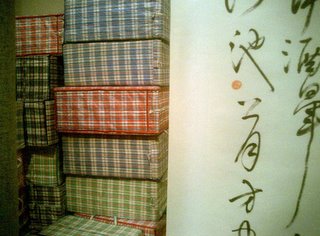
27 January 2006
Arctic clothing
 Inuit technology and resourcefulness are amazing. Darwinism in action.
Inuit technology and resourcefulness are amazing. Darwinism in action.The speakers highlighted the dangers of the arctic environment and how clothing, especially the boots, had to be perfect in all respects, otherwise the life of the wearer is at risk. Wet is one of the great dangers. Heat is seen as a fluid to be trapped round the body - yet the clothing must be loose so that excess heat can be released. Skin from caribou killed in the autumn, when the winter coat is growing in and is still short, is the best material and traditional clothes consist of one layer worn hair in, another worn hair outward. Even now a caribou layer is worn under modern clothes in cold weather.
The caribou parka that was on display comes from the handling collection. It was shedding a bit, but beautifully sewn. In fact the sewing skill is what gives these garments prestige value.
 Another type of prestige value comes from the materials used. The Greenland costume that sat on the stage was made in the 1930s for the daughter of the Danish high commissioner, and had a bead collar about three times as deep as even a high-status local would have. The central strips on the trousers are made up of tiny squares of coloured skin, and the high leggings are adorned with lace and flowers cross-stitched in pastel colours. People seized on new materials as they became available, brought in from Denmark (with its tradition of cross-stitch flower embroidery) in this case.
Another type of prestige value comes from the materials used. The Greenland costume that sat on the stage was made in the 1930s for the daughter of the Danish high commissioner, and had a bead collar about three times as deep as even a high-status local would have. The central strips on the trousers are made up of tiny squares of coloured skin, and the high leggings are adorned with lace and flowers cross-stitched in pastel colours. People seized on new materials as they became available, brought in from Denmark (with its tradition of cross-stitch flower embroidery) in this case.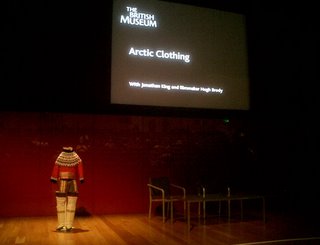 The programme included a film made in the late 1950s among the Netsilik Inuit, just filming with no commentary - or subtitles. Apparently the film was made without sound, then years later shown to the people who were in it, and they could remember what they had said, so that was recorded and dubbed.
The programme included a film made in the late 1950s among the Netsilik Inuit, just filming with no commentary - or subtitles. Apparently the film was made without sound, then years later shown to the people who were in it, and they could remember what they had said, so that was recorded and dubbed. This was at a time when Inuit (or Eskimos, in those pre-PC days) culture was on the cusp of being "modernised." Several families agreed to live in the traditional way for a year and allow filming - an early "1900s House." Apparently there was a lot of dispute about the editing and distribution, and eventually the National Film Board of Canada took it over.
The film showed the making of an igloo (deft cuts with snow knife) and a sledge (frozen caribou skin used to make the runners, with moss and ice to make it go smoothly, as well as cutting out a parka and mealtime. There are a dozen of these 20-30 minute films. Fascinating.
24 January 2006
Missoni
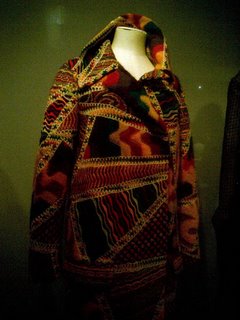 Only for the brave, is my opinion. But I've been enjoying my new Missoni bath towel, spotted at John Lewis's sale, thanks to an idea planted by Sally as we walked over there after work one evening.
Only for the brave, is my opinion. But I've been enjoying my new Missoni bath towel, spotted at John Lewis's sale, thanks to an idea planted by Sally as we walked over there after work one evening.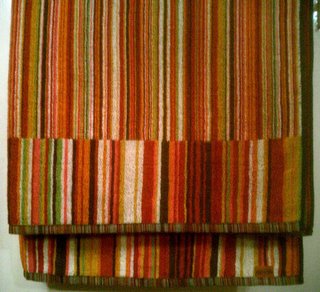
21 January 2006
Abstract art, australian
 The show also has work by Gloria Petyarr. This painting inspired my applique piece "Blown Away":
The show also has work by Gloria Petyarr. This painting inspired my applique piece "Blown Away":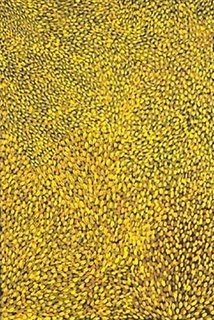 Blown Away consists of hundreds of thumbnail-sized leaf shapes. The image was once on the website of the magazine Art and Australia in an article about "bush gardens", and I used it for the second "analyse a painting" challenge on AQL (was that in 2002?) - we found a painting we liked, wrote an analysis, posted it to the group, then made a quilt based on it. Some quilts got finished, some didn't, but it was an interesting exercise. Blown Away is made in seven sections, using slightly different combinations of fabric:
Blown Away consists of hundreds of thumbnail-sized leaf shapes. The image was once on the website of the magazine Art and Australia in an article about "bush gardens", and I used it for the second "analyse a painting" challenge on AQL (was that in 2002?) - we found a painting we liked, wrote an analysis, posted it to the group, then made a quilt based on it. Some quilts got finished, some didn't, but it was an interesting exercise. Blown Away is made in seven sections, using slightly different combinations of fabric: Gloria Petyarre's works on show at the October gallery continue with the "leaf" them. She worked in the medium of batik between 1977 and 1987; it would be interesting to use the memory of her paintings as a starting-point for batik...
Gloria Petyarre's works on show at the October gallery continue with the "leaf" them. She worked in the medium of batik between 1977 and 1987; it would be interesting to use the memory of her paintings as a starting-point for batik...
But back to the paintings. Those in the display in the October Gallery look wonderful together and on the white walls. I think that to people outside Aboriginal culture, these paintings are largely enjoyed for their attractive patterning. We don't have the insider knowledge of the subject, and like anyone outside the artist's clan, are not allowed to know -- the right to paint a certain dreaming passes through the family, and though some parts are allowed to be explained to outsiders, much is not. So these paintings have to "work" on another level, fitting in with an individual's or a culture's sensibilities.
Essentially, I like the way those many dots, or strokes, build up into a bigger idea. The power of repetition and cumulation. And the power of work that emerges when people start with, and concentrate on, something so basic to their lives and that they know really well.
20 January 2006
How do we do it? - crocheting
As you can see, we found the process tense and anguishing. It definitely needed concentration.
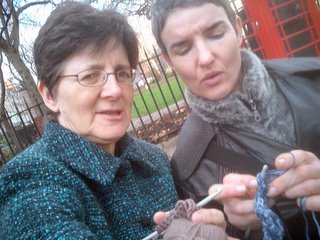
Here are some components of crocheting:
-wrapping the wool around the fingers to control the tension
-length of wool available between finger and loop, controlled by index finger on left hand
-does the hook grab the wool from in front or behind (less movement is best)
-which fingers, and on which hand, hold the work
-how is the hook held - like a pen for writing, or a brush for painting at arm's length
-does the index finger on the right hand hold the loop when the hook isn't passing wool through it
-what stitch are you meant to do next - ch. or s.c. or d.c. or t.c.
Liane is left-handed but was crocheting right-handed. (I tried crocheting left-handed. Needs practice...) She was using cotton and it was difficult to keep the tension because the cotton didn't slip easily around the fingers; later, she reported that it all went much more easily after switching to wool.
Wonderful stuff, wool.
And that little crochet hook has a lot of potential, too. More than just doilies! Take afghan stitch (tunisian crochet) - looks more like weaving than crochet. Here are basic instructions: <http://vickisdesigns.tripod.com/basics.htm>, and this site shows how to change colours: <http://home.comcast.net/~crochet_cindy/tutorial/afghan.htm>
Here's looking at you
 Combined cost? £1100. But that works out at less than the cost of a cup of coffee a day. And I couldn't be without them.
Combined cost? £1100. But that works out at less than the cost of a cup of coffee a day. And I couldn't be without them.In taking the photograph, I discovered another use for a digital camera: it lets us myopics see the world clearly without glasses!
19 January 2006
Japanese fabric
What was delightful was the little details - the shibori-dots print tape used to seal the plastic bag, the printed ribbon around the invoice, and the 5" length of chirimen cord, knotted.
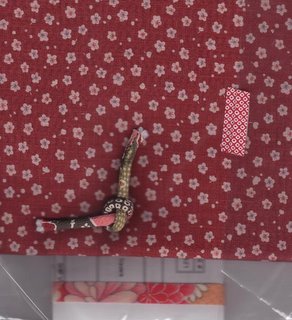
18 January 2006
Orange wrappers
Reading that in the catalogue to the Francesco Clemente exhibition at the Royal Academy in 1992 got me looking at orange wrappers.

There were lots of orange wrappers around, then. Most came from Spain.
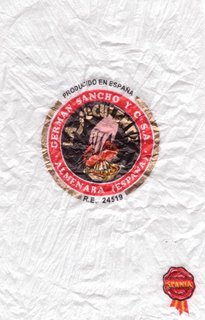 I ate SO many oranges. It was a healthy time.
I ate SO many oranges. It was a healthy time. And people, hearing of my obsession, would look for orange wrappers when they went travelling, and send them to me.
And people, hearing of my obsession, would look for orange wrappers when they went travelling, and send them to me.  I smoothed them out and stored them carefully.
I smoothed them out and stored them carefully. Sometimes I stroked and counted them. 200 ... 300 ... different ones.
Sometimes I stroked and counted them. 200 ... 300 ... different ones.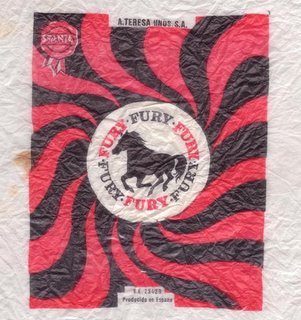 I've lost count now. They're languishing in the back of a cupboard.
I've lost count now. They're languishing in the back of a cupboard.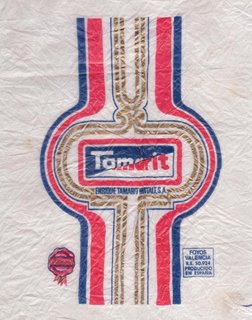 But now, you hardly ever see them any more.
But now, you hardly ever see them any more.17 January 2006
Orange fabric
16 January 2006
Camley Nature Park
 This distinctive building sits on the other side of the canal. In the 19th century, the canals were so important in moving goods round the country. In the 21st, their recreational aspects are paramount. Ever so many people were out for a walk along the towpath. What a wonderful resource, cutting through the centre of the city.
This distinctive building sits on the other side of the canal. In the 19th century, the canals were so important in moving goods round the country. In the 21st, their recreational aspects are paramount. Ever so many people were out for a walk along the towpath. What a wonderful resource, cutting through the centre of the city. Plenty of reeds in the nature park. They put them to good use, eg this hide for birdwatching:
Plenty of reeds in the nature park. They put them to good use, eg this hide for birdwatching: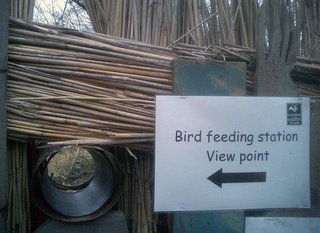 And during January and February, or as long as supplies last perhaps, people can come and pick up a tree or shrub for planting in their garden, for free.
And during January and February, or as long as supplies last perhaps, people can come and pick up a tree or shrub for planting in their garden, for free.
There's a, hmm what is he called, nature warden? and the rest of the staff are volunteers. The visitor centre obviously gets lots of local groups, and there's a library of books for kids to use.
Nice place.
14 January 2006
Scrolling
This scan from the RA Magazine gives an idea (but of course as it’s so far removed from the original, the colours are off and details fuzzy).

In the article, David Hockney says: “The fact that the scroll cannot be reproduced in a book should tell us it has modern relatives – the more recent kind of ‘scroll art’ that we see in movies and video. But the ancient scroll, which is unfurled by the viewer, offers more possibilities for viewer participation than a film in which the cameraman decides what we see.”
The viewer isn’t static, unrolling the scroll - as in life: our eyes move all over the place. The isometric perspective used doesn’t have a vanishing point. If it had a vanishing point (as in Western perspective) “the viewer would be a pinpoint in front of the picture instead of a physical participant in the viewing of the scroll... The Chinese method of painting is more narrative, more attuned to the movements of the viewer’s eye and body and their psychological engagement with the story they are unfurling.”
As part of a drawing course based around the Chinese galleries at the V&A in June 1992, we saw a video of Hockney looking at and talking about a Chinese scroll (I'd love to see it again). He may have mentioned how elements like fog help with that feeling of moving through space. At the time I went home and “evoked” fog among the buildings with some tissue paper and the financial pages from the newspaper:
 Looking at that now, I feel a quilt coming on ... but it's the first day of the new term of Chinese classes, and time to pack up and head into town. Somehow, during the break, though I'd planned (or hoped) to do some revision or reading every day, it didn't happen most days. In fact I seem to have forgotten just about everything learnt over the past 3 years. Use it or lose it!
Looking at that now, I feel a quilt coming on ... but it's the first day of the new term of Chinese classes, and time to pack up and head into town. Somehow, during the break, though I'd planned (or hoped) to do some revision or reading every day, it didn't happen most days. In fact I seem to have forgotten just about everything learnt over the past 3 years. Use it or lose it!
Scrolling
This scan from the RA Magazine gives an idea (but of course as it’s so far removed from the original, the colours are off and details fuzzy).

In the article, David Hockney says: “The fact that the scroll cannot be reproduced in a book should tell us it has modern relatives – the more recent kind of ‘scroll art’ that we see in movies and video. But the ancient scroll, which is unfurled by the viewer, offers more possibilities for viewer participation than a film in which the cameraman decides what we see.”
The viewer isn’t static, unrolling the scroll, as in life: our eyes move all over the place. The isometric perspective used doesn’t have a vanishing point. If it had a vanishing point (as in Western perspective) “the viewer would be a pinpoint in front of the picture instead of a physical participant in the viewing of the scroll... The Chinese method of painting is more narrative, more attuned to the movements of the viewer’s eye and body and their psychological engagement with the story they are unfurling.”
As part of a course based around the Chinese galleries at the V&A (in 1994 or so), we saw a video of Hockney looking at and talking about a Chinese scroll. He may have mentioned how elements like fog help with that feeling of moving through space. At the time I went home and “evoked” fog among the buildings with some tissue paper and the financial pages from the newspaper:

12 January 2006
What the cat brought in
They loved that mouse to bits:
 Here's what it looked like when it was new:
Here's what it looked like when it was new: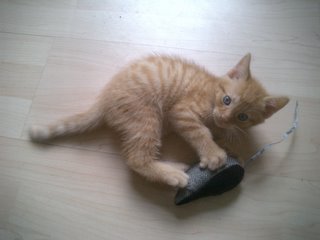
Are they too old for another? They were neutred this week. It's a cat's life...
10 January 2006
Garment sewing
Because there's not a lot of stuff, it's easier to concentrate on one thing at a time.
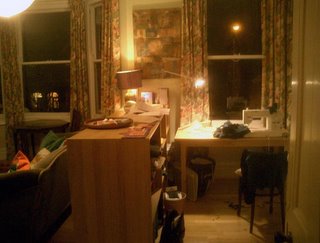 This coat is the first thing I made here - after doing no garment sewing for years. I'm delighted to find that I still remember how to do all this. I used a pattern but changed the pockets completely, just went ahead and did it and hoped for the best - and it worked fine.
This coat is the first thing I made here - after doing no garment sewing for years. I'm delighted to find that I still remember how to do all this. I used a pattern but changed the pockets completely, just went ahead and did it and hoped for the best - and it worked fine.The little round buttons are turks head knots done in a satin cord - found them at Rolls N Rems on Seven Sisters Road. They cost 15p each, what a bargain.
 And there was enough fabric left for this jacket, which took 8 1/2 hours start to finish. The coat pattern got reused, with a few little changes. The lining (also left over from the coat and also from Rolls N Rems, which has more stock than John Lewis) has secret pockets.
And there was enough fabric left for this jacket, which took 8 1/2 hours start to finish. The coat pattern got reused, with a few little changes. The lining (also left over from the coat and also from Rolls N Rems, which has more stock than John Lewis) has secret pockets.
Tony found "Esmerelda" in the loft and has oiled her adjustment wheels and given her a scrub. She needs a stand, but meanwhile is quite happy on the old treadle that Tony oiled and refurbished last year.
Aftermath
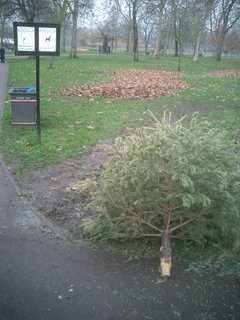 As I entered the park on the way to work, the path was blocked by a tractor and trailer being loaded up with dumped trees. The man loading it looked like Old Saint Nick, rosy cheeks and cheery countenance, but wearing green. I didn't have the presence of mind to ask if he'd pose for a photo.
As I entered the park on the way to work, the path was blocked by a tractor and trailer being loaded up with dumped trees. The man loading it looked like Old Saint Nick, rosy cheeks and cheery countenance, but wearing green. I didn't have the presence of mind to ask if he'd pose for a photo.
Here's what happens next - the trees are gathered in the works yard and put through the chipper.
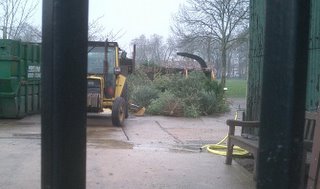
And what to do with other things you no longer need? If you're doing a big house clearance, but don't want to hire a skip (or don't have enough to fill one), why not just leave your rubbish on the street? It happens even in the "nice" Queens Park area. This household was being ever so tidy about leaving their rubbish on the street!
08 January 2006
Journey quilt series
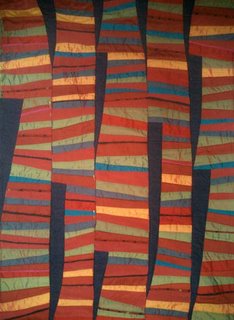 The first piece, still unfinished (it's backed but I can't quite decide about the quilting) is now called Journey of a Lifetime. I made a bagful of strips (3cm to 7cm wide, some angled) of shot silks, and another of recycled red silks, to be stitch 'n' flipped onto strips of (prewashed) domette.
The first piece, still unfinished (it's backed but I can't quite decide about the quilting) is now called Journey of a Lifetime. I made a bagful of strips (3cm to 7cm wide, some angled) of shot silks, and another of recycled red silks, to be stitch 'n' flipped onto strips of (prewashed) domette.To "choose" which strip to use next I tossed a coin - heads for red, tails for colour - then pulled any old piece out of the bag. When the toss came up same again, I inserted a narrow, folded strip of a plaid silk. Working on several of the long strips allowed for chain piecing.
The width of the foundation strips was carefully chosen, but their order in the finished quilt was decided on the basis of the flow of colour. And when it was laid out, the random events had indeed tended to the average - it looked dull! - hence the stabs of dark blue, added before sewing the strips together. It's those bits of darkness that are making the problem for deciding how to quilt it.
While pondering this important question I did a little rummaging in the drawerful of old projects and found lots of bits of fabric printed in a class years ago, using bubble wrap and monoprinting and ends of thread spools and bits of cardboard, as you do. It was the work of moments to reduce them to strips and find some small dark plaids from recycled shirts.
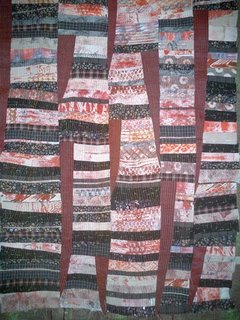 The title Desert Journey soon emerged for this piece. To impose randomness I used a throw of the dice, after sorting the strips into six bags. The pieces of lime green print on black background went into a bag on their own - but ran out halfway up and I needed to find something else a bit edgy for the rest. This kind of shift is something to use deliberately another time.
The title Desert Journey soon emerged for this piece. To impose randomness I used a throw of the dice, after sorting the strips into six bags. The pieces of lime green print on black background went into a bag on their own - but ran out halfway up and I needed to find something else a bit edgy for the rest. This kind of shift is something to use deliberately another time.The photo shows ragged edges but the quilt has been finished. I quilted it closely in sand-coloured threads, with the feed dogs up and a regular presser foot. The lines of stitching run in parallel swoops that echo and amplify the shapes of the solid inserts (these are silk). The edges of the quilt are faced and turned to the back. They're stepped at top and bottom, following the ends of the vertical strips, and smooth on the sides.
Both those quilts are about 80cm x 110 cm, but the third random quilt is smaller. It uses scraps from "Journey in the Midnight Garden", which I'll write about another time. This small piece, still unfinished because I can't decide on the quilting [is there a theme here?] has no title yet. Maybe that's what's holding it back?
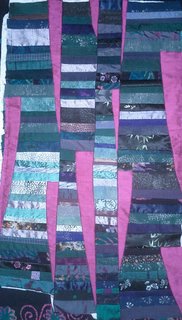 In the lower left you can see the backing and the stepped ending of the strips. By now I was putting the long strips together in a different way. At first I'd overlapped them, turned the edge under, and handstitched, using a ladder stitch. Here I machined around the edge and used those lines as a guide for machining the strips together.
In the lower left you can see the backing and the stepped ending of the strips. By now I was putting the long strips together in a different way. At first I'd overlapped them, turned the edge under, and handstitched, using a ladder stitch. Here I machined around the edge and used those lines as a guide for machining the strips together.It takes a while, as with any quilt, to select the fabrics and group them, but after that the randomness makes the sewing painless.
07 January 2006
Out of chaos?
I've moved the laptop from the dining table to the desk -- which wasn't being used because it got heaped up with letters and papers needing attention, but being neglected. Those heaps just got pushed to the side and the laptop sat in the middle, and I tried to ignore them.

By the time this "before" picture was taken, I'd already worked through some of the pile, but it was still constantly there and unignorable -- not far enough out of sight. Or maybe it was an in-vino-veritas moment. Action was definitely called for, and within moments the heap had been sorted (it never takes as long as you thought it would).
January's housekeeping habit is to keep the desk CLEAR, and January's major task is to declutter the shelf directly behind it.
There's nothing like a photograph for revealing things you've gotten used to seeing. Those wires, now ....



